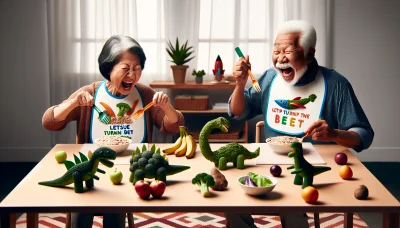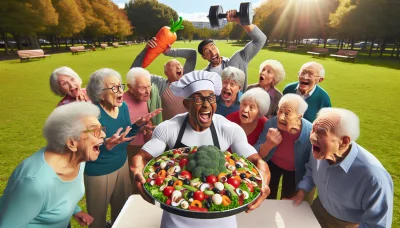Chuck norris healthy aging Quiz
Test Your Knowledge
Question of
Chuck Norris's Approach to Healthy Aging
Embracing Martial Arts for Longevity
Chuck Norris, a martial arts icon, has exemplified aging with vigor. By integrating martial arts into his lifestyle, he showcases how this ancient practice can contribute to longevity. Martial arts offer a full-body workout, improving cardiovascular health, strength, flexibility, and balancekey components for staying fit as one ages.
Martial arts don't just keep the body young; they also encourage a lifelong learning mindset. Practitioners often continue to develop their skills, proving that age is not a barrier to advancement. This continuous growth keeps the mind and body engaged, fostering an environment ripe for healthy aging.
The Benefits of Consistent Training
Consistency is king when it comes to reaping the benefits of any exercise regimen. Regular martial arts training ensures that muscles and joints remain active, which is crucial in maintaining mobility and preventing atrophy. Consistency also helps in managing weight and reducing the risk of chronic diseases like diabetes and heart disease.
Moreover, consistent training establishes a rhythm in one's life, leading to improved sleep patterns and increased energy levels. These factors are instrumental in promoting overall well-being and vitality throughout the aging process.
How Martial Arts Improve Mental Health
Martial arts are not just about physical prowess; they're equally about mental fortitude. Training incorporates meditation and breathing techniques that reduce stress and enhance focus. This mental clarity translates into better decision-making and emotional stability.
The social aspect of martial arts should not be overlooked either. Joining a community of like-minded individuals provides support and camaraderie, which are essential for mental health as one ages. It's this blend of physical exertion and social interaction that makes martial arts a comprehensive approach to maintaining mental wellness.
The Role of Discipline in Aging Gracefully
Discipline shapes Chuck Norris's philosophy on aging gracefully. It's about making intentional choices daily that contribute to long-term health. Adhering to a disciplined lifestyle means prioritizing self-care and recognizing the importance of staying active both mentally and physically.
- Developing a Routine for Daily Wellness: Establishing regular habits such as balanced eating, adequate hydration, and consistent exercise can make a significant difference in how one ages.
- The Importance of Mental Resilience: Cultivating a resilient mindset prepares one to handle life's challenges without succumbing to stress. Disciplined mental practices like mindfulness or positive thinking reinforce this resilience.
Nutrition Secrets for Staying Young
The Chuck Norris Diet: Key Components
Balancing Macronutrients for Energy: To maintain vitality, it's essential to balance carbohydrates, proteins, and fats. Carbohydrates are your body's fuel, proteins are the building blocks, and fats are crucial for hormone production. Chuck Norris's approach emphasizes the quality of these macronutrients, sourcing from whole foods for maximum nutritional benefit.
Importance of Hydration and Micronutrients: Water is the elixir of life! Staying hydrated aids in digestion, absorption of nutrients, and elimination of toxins. Micronutrients, including vitamins and minerals, play a pivotal role in maintaining youthful vigor. A diet rich in fruits and vegetables ensures an abundant supply of these vital nutrients.
Superfoods Chuck Norris Swears By
Antioxidant-Rich Foods for Cellular Health: Combat aging at the cellular level with antioxidants. These miraculous molecules counteract oxidative stress that contributes to aging. Berries, dark chocolate, and green tea are potent sources that can help keep your cells young and functioning optimally.
Omega-3 Fatty Acids for Brain and Heart: Omega-3s are superheroes for your heart and brain health. Found in fatty fish like salmon, these essential fats reduce inflammation and have been linked to lower risks of heart disease and cognitive decline. Incorporating omega-3-rich foods into your diet can be a game-changer for longevity.
- Eat a variety of colorful fruits and vegetables to ensure a broad spectrum of antioxidants.
- Include lean protein sources like chicken or tofu to build and repair tissues.
- Select whole grains over processed ones to maintain energy levels throughout the day.
- Savor fatty fish twice a week for a hearty dose of omega-3 fatty acids.
- Snack on nuts and seeds they're packed with beneficial fats and minerals.
- Stay hydrated by drinking water regularly throughout the day.
- Leverage herbs and spices not only for flavor but also their impressive antioxidant content.
Fitness Routines That Promote Healthy Aging
Tailoring Workouts to Your Age and Ability
Starting a fitness journey isn't a one-size-fits-all scenario. As we age, our bodies require workouts that cater to our changing abilities. It's crucial to assess your current fitness level and adjust your routine accordingly. This ensures that you're getting the most benefit without putting yourself at risk for injury.
Consulting with healthcare professionals can provide insights into which exercises are most suitable for you. They can help you design a balanced routine that combines cardiovascular, strength, flexibility, and balance training - all key components for maintaining health as we age.
Low-Impact Exercises for Joint Health
Low-impact exercises are the cornerstone of joint-friendly fitness routines for seniors. Activities like swimming, cycling, and walking preserve joint health while offering cardiovascular benefits. They're perfect for those with arthritis or other conditions that make high-impact movements challenging.
Yoga and Pilates also rank high on the list for promoting flexibility and strength without straining the joints. These practices can improve posture, reduce stress, and enhance mobility, proving that gentle movements have powerful effects on our well-being.
Strength Training to Combat Muscle Loss
Sarcopenia, the gradual loss of muscle mass as we age, can be mitigated through regular strength training. Incorporating resistance bands, free weights, or bodyweight exercises helps maintain muscle function and metabolic health.
It's not about lifting heavy; it's about engaging muscles consistently to preserve strength and independence. Strength training should be approached carefully, with proper technique being paramount to prevent injuries.
Consistency Over Intensity in Exercise
When it comes to aging gracefully with exercise, consistency trumps intensity. Regular physical activity is more beneficial than sporadic high-intensity workouts which can increase injury risk. Aim for moderate activity most days of the week to maintain a healthy lifestyle.
Consistent exercise helps manage chronic conditions, improves mental health, and boosts energy levels. It's about creating sustainable habits that will support your health long-term rather than seeking quick results.
Setting Realistic Fitness Goals
- Start with attainable objectives based on your current fitness level.
- Incorporate activities you enjoy to maintain motivation.
- Gradually increase difficulty to avoid burnout and injury.
- Track progress to celebrate achievements and refine goals.
- Seek professional guidance when necessary to ensure proper form.
- Be patient with your progress; physical improvements take time.
- Listen to your body's signals to avoid overexertion.
The Role of Recovery and Rest Days
Recovery is an essential component of any exercise regimen, especially as we age. Rest days allow muscles to repair themselves and grow stronger. Ignoring recovery can lead to overtraining syndrome which hampers performance gains.
Including active recovery methods such as stretching or light walking can enhance flexibility and blood circulation during rest periods. Remember, recovery is just as important as the workout itself for overall health improvement.
Mindfulness and Mental Well-being
Meditation Practices for Stress Reduction
Meditation is a powerful tool for alleviating stress, improving concentration, and promoting inner peace. By practicing regularly, individuals can significantly lower their stress levels and enhance their overall quality of life. The beauty of meditation lies in its simplicity and accessibility; no special equipment is needed, just a few minutes of your day.
Scientific studies back the benefits of meditation, showing that it can lead to decreased anxiety and better mood regulation. It fosters a sense of calm that can permeate all aspects of life. With consistent practice, meditation contributes to a more resilient stress response, helping people face challenges with greater equanimity.
Guided Meditation for Beginners
For those new to meditation, guided sessions provide an excellent starting point. These sessions involve following a narrator's instructions, which help focus the mind and eliminate distractions. Guided meditations come in various forms, such as apps or online videos, making them highly accessible for everyone.
Beginners often benefit from the structure provided by guided meditations. They offer a supportive way to explore different techniques and find what works best for you. Starting with just five minutes a day can lay the foundation for a lifelong practice that grows with your experience.
Deep Breathing Techniques for Relaxation
Deep breathing is another cornerstone of stress reduction. It's an integral part of meditation that can also be practiced on its own. This simple technique involves slow, deliberate breaths that help to calm the nervous system and reduce tension.
The practice of deep breathing activates the body's relaxation response, counteracting the effects of stress. It's particularly effective because it can be done anywhere, at any timewhether you're at your desk or on public transport. Consistent practice enhances its benefits, making it a quick go-to tool for immediate relief.
Staying Mentally Active with Age
Maintaining mental agility as we age is crucial for preserving cognitive health and overall well-being. Engaging in mentally stimulating activities not only keeps the brain sharp but also helps in reducing the risk of cognitive decline associated with aging.
A proactive approach to brain health can have long-lasting effects. Activities such as reading, playing musical instruments, or learning new skills are not just hobbies; they're investments in our cognitive reserve. This reserve builds up over time and provides a buffer against age-related changes in brain function.
Cognitive Exercises to Sharpen the Mind
- Crossword Puzzles: Challenge your language skills and improve vocabulary while giving your brain a workout.
- Sudoku: Develop problem-solving abilities and enhance logical thinking through number placement puzzles.
- Memory Games: Boost memory retention and recall by matching patterns or sequences in these fun exercises.
- Brainteasers: Tackle complex problems that require creative thinking to strengthen mental flexibility.
- Educational Classes: Enroll in courses on subjects like history or science to stimulate intellectual curiosity and knowledge retention.
- Social Interaction: Engage in discussions or group activities that encourage conversation and idea exchange to keep the mind active.
The Importance of Lifelong Learning
Lifelong learning plays an essential role in keeping our minds engaged and active throughout our lives. It opens doors to new experiences and ideas, fostering an adaptable and open-minded approach to life's challenges.
Taking up new hobbies or studying subjects outside one's comfort zone stimulates neural pathways associated with learning and memory. This commitment to continuous growth not only enriches personal development but also contributes to sustained mental acuity into later years.
Understanding the Impact of Diets on Aging
Debunking Myths About Fad Diets
Fad diets often promise quick weight loss and other health benefits, but their effects can be fleeting and sometimes harmful. Many lack essential nutrients, which can lead to long-term health issues and accelerated aging. It's crucial to approach such diets with skepticism and prioritize evidence-based dietary advice.
The allure of rapid results can overshadow the reality that these diets are not sustainable. They can lead to a cycle of weight loss and gain, known as yo-yo dieting, which has been linked to increased mortality and decreased lifespan. Understanding these risks is vital in making informed dietary choices.
Long-Term Effects of Yo-Yo Dieting
Yo-Yo dieting can wreak havoc on ones metabolic rate, causing it to slow down and make weight management more challenging. This pattern of weight cycling has been associated with higher body fat percentage and greater risk of muscle loss, both factors that contribute to premature aging.
Additionally, the stress caused by repeated dieting can accelerate the aging process by increasing oxidative stress and inflammation in the body. This underscores the importance of stability in dietary habits for both longevity and overall well-being.
Evaluating Diet Trends for Nutritional Value
When a new diet trend emerges, it is critical to assess its nutritional value. Diets should provide a balance of macronutrients and micronutrients necessary for maintaining health. Trendy diets that eliminate entire food groups without scientific backing may compromise long-term health and accelerate aging.
- Investigate the source of dietary claims are they supported by reputable scientific research?
- Consider the diet's inclusivity of all food groups to ensure a balanced intake of nutrients.
- Analyze whether the diet provides adequate calories for energy and sustenance.
- Look at the diet's feasibility for long-term adherence as temporary fixes can lead to yo-yo dieting.
Adopting a Sustainable Eating Lifestyle
To positively influence aging, adopting a sustainable eating lifestyle is key. This involves choosing whole foods over processed ones, incorporating a variety of nutrients into your diet, and understanding that moderation is essential for balance. A sustainable approach supports long-term health without the adverse effects associated with fad diets.
Principles of a Balanced Diet
A balanced diet includes carbohydrates, proteins, fats, vitamins, minerals, and water in appropriate proportions. It supports all bodily functions, contributes to disease prevention, and aids in managing healthy aging. Eating a variety of foods ensures no nutrient deficiencies that could potentially speed up the aging process.
Mindful Eating Habits for Health Preservation
Mindful eating is about being present during meals and listening to your body's hunger cues. It promotes better digestion and satisfaction with smaller portions which can prevent overeating and support longevity. Being mindful also means making conscious choices about food quality, prioritizing nutrient-dense options that nourish the body over time.
Leveraging Natural Supplements for Age-Defiance
Essential Vitamins and Minerals for Seniors
As we age, our nutritional needs evolve, making it crucial to focus on essential vitamins and minerals. Seniors should prioritize their intake of specific nutrients to maintain health and vitality. A well-rounded diet supplemented with key vitamins can significantly impact overall well-being and age-defiance.
A strategic approach to nutrition can help combat the natural decline in physiological functions. Incorporating a spectrum of vitamins and minerals into the daily regimen is not just recommended; it's a game-changer for aging individuals aiming to preserve their zest for life!
Vitamin D and Calcium for Bone Health
Vitamin D and calcium are the dynamic duo when it comes to maintaining strong bones in senior years. The risk of osteoporosis skyrockets as we age, but with adequate levels of these nutrients, you're setting the stage for a sturdy skeletal structure. Don't underestimate the power of the sun; it's your ally in synthesizing vitamin D naturally.
Calcium's role in bone health is irrefutable, yet without enough vitamin D, calcium cannot do its job effectively. It's like having a superhero without their sidekick! Together, they work tirelessly to protect your framework against the test of time.
Antioxidant Supplements to Protect Cells
Antioxidants are the body's guardians, shielding cells from oxidative stress and the ravages of free radicals. These molecular marauders accelerate aging, but antioxidants stand firm in defense of cellular integrity. Think of them as your personal anti-aging warriors!
Incorporating antioxidant supplements such as Vitamin C, Vitamin E, and selenium can be transformative. They're not just supplements; they're an investment in longevity, helping you maintain that youthful spark. Embrace these cellular custodians and watch them work wonders on your well-being.
Herbal Remedies and Their Anti-Aging Properties
The plant kingdom is brimming with secrets to longevity, offering herbal remedies that have stood the test of time. These natural wonders come packed with anti-aging properties that modern science continues to acknowledge and embrace. It's time to turn back the clock with nature's own elixirs!
Herbs are not just culinary enhancers; they're potent allies in the quest for ageless living. With minimal side effects compared to synthetic drugs, herbal remedies offer a harmonious path to preserving youthfulness.
Ginseng for Energy and Vitality
Ginseng is a revered adaptogen known for its ability to boost energy levels and enhance vitality among seniors. It's like flipping on a switch within, igniting a spark that fuels your day-to-day activities with renewed vigor. Ginseng doesn't just wake you up; it recharges your biological batteries!
- *Enumerative Lists: Used for itemizing elements, events, or tasks, often in a specific order. Ordered Lists: Sequence matters (e.g., procedural steps, rankings). Unordered Lists: Sequence does not matter (e.g., grocery lists, to-do lists). *Descriptive Lists: Each item is accompanied by additional details or a description. Useful for catalogs, menus, or directories. *Checklists: Designed for tracking completion or presence of items or tasks. Common in project management, inspections, and daily routines. *Multilevel Lists: Nested lists with items having sub-items. Useful for outlining complex information, hierarchical data, or detailed plans. *Matrix Lists: Information presented in a two-dimensional grid or table format, where lists are organized both vertically and horizontally. *Priority Lists: Items are organized based on their importance or urgency. Common in project management and personal productivity systems. *Comparative Lists: Used for juxtaposing two or more items, options, or ideas, often to highlight differences or similarities.
Turmeric for Its Anti-Inflammatory Benefits
Turmeric isn't just a spice that gives curry its vibrant color; it's also imbued with curcumin nature's answer to inflammation. Chronic inflammation is an insidious enemy of youthfulness; turmeric is here to fight that battle on your behalf.
This golden spice supports graceful aging by promoting healthy inflammatory responses within the body. Making turmeric part of your daily regimen could be the secret spice of life you've been looking forembrace its golden goodness!












